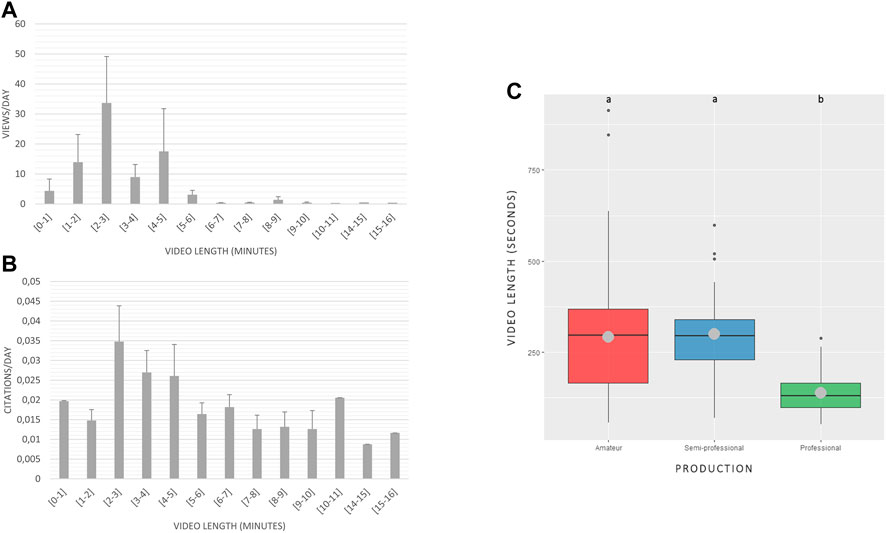Video abstracts: a tool to increase the impact of scientific papers
By Carolyn Pralle
Title: Audio-Visual Tools in Science Communication: The Video Abstract in Ecology and Environmental Sciences
Author(s) and Year: Miguel Ferreira, Betina Lopes, António Granado, Helena Freitas, and João Loureiro; Published in 2021
Journal: Frontiers in Communication (Open Access)
| TL;DR: Video abstracts are becoming more popular among scientific researchers, with immense variety in their production. In this paper, two-to-three-minute videos were found to have the highest views. Additionally, documentary-style or animated videos were associated with higher paper citations per day than with simple presentations, dynamic presentations, or monologues. Why I chose this paper: As an ecologist, I have experimented with science storytelling through filmmaking, finding it both challenging and fun! |
Would you be more interested in engaging with a scientific paper if it came with a video abstract? Can a video help scientists get more citations on their paper? Ferreira et al. investigated these questions, amongst others, to better understand video abstracts as a science communication tool.
The Background
Science communication (scicomm) often happens through writing, especially in the context of published scientific research. Now, videos and films are gaining popularity as a format for scicomm because videos are effective at eliciting emotional engagement from viewers. In this study, the authors investigated the relatively new genre of video abstracts, which use audio-visual tools to communicate a study’s abstract, including its framework, methods, results, and conclusions, sometimes also including future goals.
According to Zong et al. 2019, papers with video abstracts were viewed and cited more than text-only papers. The authors looked at three metrics generated by Altmetric, a tool for tracking the impact of papers online via reference managers, wikis, and social media. Using the metrics of 1) views, 2) citations, and 3) Altmetric scores, the authors assessed the impact of the video abstracts. The authors studied video abstracts from ecology and environmental science journals for 1) their interest in how these fields address wide-ranging environmental challenges and 2) the precedent of using film (i.e. nature documentaries) in these fields for communicating science.
The Method
The authors collected 171 video abstracts from 29 scientific journals. They chose these 29 journals from six different publishers because of their high impact factors. They watched and analyzed the video abstracts, developing categories for different characteristics of each video. This analysis included collecting three categories of data:
- General metrics about each video abstract (video title, length, views, video age, likes/dislikes, etc.)
- General metrics from the associated scientific paper (number of citations, Altmetric value, publication date, and more)
- Contact factors for each video in relation to:
- Production: professional, semi-professional, or amateur
- Narration: number and gender of narrators, first person or third-person
- Other factors such as shooting location, video format (including use of animation or graphics), number and type of shots (i.e. close-ups, long shots), sound design/audio quality, and more
After the first round of categorizing (data coding), 30 other coders reviewed representative samples from the set of videos. This helped ensure consistency and reliability across the different ways that the coders categorized each video. After the coding was completed, the authors used generalized linear models to statistically analyze their corpus of data.
The Results
The authors found that the occurrence of video abstracts increased sevenfold from 2010 to 2018, showing a steady pattern of scientists increasingly using video abstracts. Nearly half of all video abstracts (47%) were 1-3 minutes long. Video abstracts that were 2-3 minutes long had the highest number of views per day and a stronger relationship with citations per day compared to shorter or longer videos (Figure 1, parts A and B). Half of videos (50%) were amateur productions, while 38% used professional media companies and 12% were semi-professional. The amateur videos tended to be longer than professional productions (Figure 1, part C), suggesting a link between production value and video length.

Most videos used traditional styles like documentaries (46%) or simple presentations (23%), while others used animations (16%), dynamic presentations (11%) and monologues (4%). The documentary and simple presentation styles had the most views per day, but documentary and animation had the highest average number of citations per day. With Altmetric scores (the measure of impact outside peer-reviewed media types), animated videos tended to have higher impact. Surprisingly, audio quality made little difference on the number of views, but poor audio quality did reduce the number of citations per day and Altmetric values.
The Impact
Video abstracts are growing in popularity as a way to increase impact of, and engagement with, scientific research in ecology and environmental sciences. Video abstracts had the greatest impact (measured as views and citations per day and higher Altmetric scores) when they were: A) 2-3 minutes long, and B) professionally or semi-professionally produced.
The authors point out that the genre of video abstracts is still new. As such, the variety of content factors and creativity of the video producers make clear-cut analysis challenging in this new genre. The range of data from this sample indicates a disorganization in how the videos reach their audiences (e.g. the same journal publishing video abstracts on different websites and streaming channels), complicating the measurement of a video abstract’s impact. The authors recommend future research on video abstracts, hinting at their development of a theoretical framework and a validation model for evaluating video abstracts.
Edited by Michael Golden and Niveen AbiGhannam
Cover image credit: ErikaWittlieb from Pixabay

